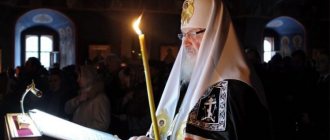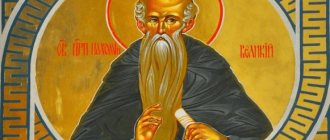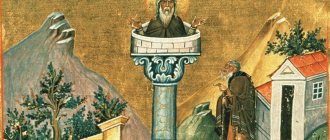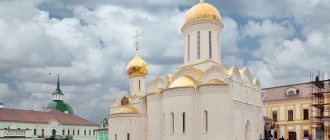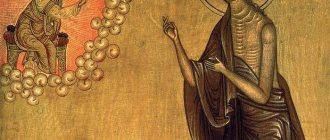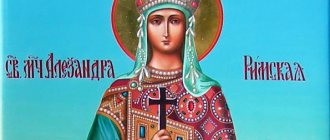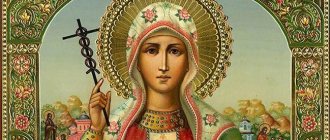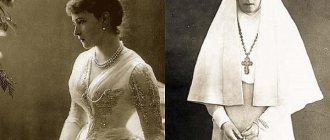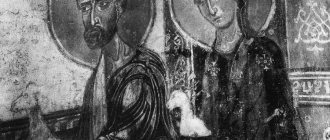The Venerable Martyr Andrew of Crete (in other sources Andrew of Jerusalem) is a famous Christian theologian who wrote a large number of spiritual hymns. He preached actively throughout his life.
He was an archbishop in the city of Gortyn, which is located on the island of Crete. He lived a long righteous life and died in 740 on the island of Lesbos. After his death he was canonized as a saint.
July 17th
Memorial Day of Andrei Kritsky
The image of Andrew of Crete on a fresco in a seventeenth-century temple
Memorial Day of Andrei Kritsky - July 17 (4 old style).
The reverend's childhood and origins
Andrew of Crete was born in the seventh century in Damascus. His parents were believing Christians. According to legend, the boy was mute from birth, and after receiving the Holy Mysteries of Christ he suddenly gained the gift of speech. This happened when he was seven years old, so Andrei remembered such an extraordinary event for the rest of his life.
Since childhood, he prayed a lot and did not play with his peers. And in adolescence, he firmly decided to devote his life to serving God. At the age of fourteen he went to the monastery of St. Sava near Jerusalem.
ANDREY
The main and earliest source about the life and work of A. is the life compiled before 843 by the patrician and quaestor Nikita (BHG, N 113), which was later revised several times and became famous. handwritten Great Menaion of Chetia. This monument contains detailed biographical information about A., but is silent about him as a hymnographer and compiler of the Great Canon. The second most important source is the life of A., written by Mon. Macarius Makris in 1422 (BHG, N 114; published by V. Laurdas) and translated into modern Greek. language of St. Nicodemus Svyatogorets as part of his “New Collection” (Νέον ̓Εκλόγιον), which testifies to A. as a rhetorician, hymnographer and melurgist, the author of many canons and troparions. There is also a short life (BHG, N 114a) as part of the Imperial Minology of 1034-1041. (published by V.V. Latyshev, 1912). The encomium of Joseph Kalofet († 1355) in a 14th-century manuscript remains unpublished. from the Monastery of Pantocrator (BHG, N 114c).
According to the life compiled by Nikita, A.'s parents' names were George and Gregory. Until the age of 7, the child was mute and spoke only after receiving Holy Communion. He received his primary education in Damascus, where he studied the basics of grammar, rhetoric and philosophy. At the age of 15, A. entered the Holy Sepulcher Brotherhood at the Church of the Resurrection in Jerusalem, where he was tonsured a monk, ordained a reader, and then appointed a notary and housekeeper. In the fall of 685, after the acts of Om. VI Council were sent to Jerusalem and accepted by the Jerusalem Church, A., together with 2 monks, delivered them to K-pol. Remaining in the capital of Byzantium, A. was ordained deacon c. St. Sophia and served in this rank for over 20 years; he was in charge of an orphanage and an almshouse at the Church of St. Sophia. Under the Polish Patriarch Cyrus (706-712), A. was consecrated bishop and received an appointment to the see in the city of Gortyn (Island of Crete) with the title of Archbishop of Crete. According to the testimony of St. Theophan the Confessor, at the Council convened by Emperor. Philippicus for the renewal of monothelitism (712), A. together with bishop. Kizichim St. German, bud. Patriarch of Poland, was among those who signed the anathema of the VI Ecumenical. To the cathedral. Afterwards A. repented of signing the heretical definition; Tradition associates the composition of his famous Great Canon with this event. After the overthrow of Philippicus in 713, Orthodoxy was restored, and the lists of acts of the VI Ecumenical. The Council was again sent out, accepted and signed by all the former. participants of the Council of 712. In Crete, A. built churches, including in the image of Blachernae in K-pol, set up shelters and almshouses. Through the prayers of the saint, numerous miracles were performed. Several Once A. made trips to K-pol, in 740, on the way to Crete, he fell ill and died on the island of Lesbos, where his relics were placed in the temple of the monastery. Anastasia (now the Church of St. Andrew of Crete). Author Russian anonymous pilgrimage to Constantinople (late 13th - early 14th centuries) and Stefan Novgorodets (1348-1349) talk about healings from the incorruptible relics of A., located in the Polish monastery named after him (Book of Walkings. p. 86, 97).
In Greek There are approx. 60 sermons on church holidays attributed to A., of which approx. 30. He undoubtedly owns the Words for the Nativity of Christ, the Circumcision, the Transfiguration, the Annunciation, the Nativity of the Most Holy. Theotokos, Presentation into the Temple, Conception of the Blessed Virgin Mary. Theotokos, Dormition, Exaltation of the Holy Cross, Beheading of St. John the Baptist, on the days of remembrance of the apostles and evangelists Luke and John the Theologian, righteous Joachim and Anna, holy unmercenaries Cosmas and Damian, St. Nicholas, St. Patapia, 10 martyrs, martyr. St. George the Victorious; from the cycle of the Lenten and Colored Triodion: on the Week of the Publican and the Pharisee, meat and cheese, Vaiy, on St. Pentecost, about the veneration of St. icons, on Saturday of the Akathist, on the four-day Lazarus, on the suffering of the Lord, on the paralytic, on the Holy Spirit. Doubtful and false words include the following Words: about Jacob, the brother of the Lord (Ed. J. Nordet, H. Gaspart. Toronto, 1978), about “The Virgin Mary, brought three years old into the temple,” about the prodigal son, about the one possessed by the evil one, about the Holy Scriptures , about the purification of the soul, etc. A complete list of genuine and dubious encomia of A. and a list of incipits of homilies of A. was compiled by N. Tomadakis (Τωμαδάκης Ν. Β. ῾Η Βυζαντινὴ ὑμνογραφία καὶ ποίησις. Θεσσαλονίκη, 19934. Σ. 197-201.). A.'s sermons are written in the Attic dialect, the language is full of metaphors and symbols. According to modern The Typikon is supposed to be read at the morning of the corresponding holidays. 3 Words of the saint - on the Nativity of the Theotokos, on the Dormition of the Theotokos and on the Holy Week.
A. is also known as a melod, i.e., the author of texts and melos, many irmos, self-vocal troparions and self-vocal stichera, preserved in handwritten and printed Irmologia, Menaions, Triodions, Stichirariums, Theotocaries (see Theotokarya). N. Tomadakis associates the name of A. with the creation of the genre of the 9-song canon, which replaced the kontakion in liturgical practice. The most famous canon of A., a Byzantine masterpiece. spiritual poetry - the repentant Great Canon, consisting of 250 troparia and 11 irmos, telling about the stories of the Fall and repentance in the OT and NT (the crime of the commandment by Adam, the murder of Abel by Cain, the repentance of King David and the tax collector, etc.). The language of the Great Canon is replete with quotations from biblical texts, allusions to the hymns of St. Gregory the Theologian, St. Roman Sladkopevets. After 1204, Akaki Savvait compiled a commentary on the Great Canon, mentioning the victory of the emperor. Basil II over the Bulgarians, the foundation of Mosinopolis and containing information about the conquest of K-field by the Latins (Richard M. // ΕΕΒΣ. 1965. T. 34. Σ. 304-311). There is also an anonymous comment in the GIM manuscript. Syn. Greek 2/II (Vlad. 312). A. wrote canons both for his own irmos and for the irmos of St. Herman, St. John of Damascus, St. Kosma Maiumsky. In addition to the Great Canon, A. belongs to the canons of the main Byzantines. church holidays, most of them are included in the modern. liturgical books: canons of the Nativity of Christ, Epiphany, Presentation, Annunciation, Holy Week, Easter, Transfiguration, Nativity of the Virgin Mary, Conception of St. Anna, Nativity of John the Baptist, Beheading of John the Baptist, on the days of remembrance of the Saints Maccabees, worship of the chains of St. Peter, Saints Gregory the Theologian and John Chrysostom and on the day of the discovery of his relics, martyr. George, martyr. Codrata, St. Ignatius the God-Bearer, St. Thekla, St. Nicholas, St. Patapia, as well as canons, three songs, four songs and self-vocal stichera for many days of the Lenten and Colored Triodeum cycle (for example, the three songs and four songs of Holy Week, the canon of Easter, which is now not printed in liturgical books, etc.). Canon of the Dormition of St. The Mother of God, according to the Evergetian Rule (12th century) placed on the pre-celebration of the Dormition, was preserved only in glory. lists (GIM. Khlud. No. 156, late XIII - early XIV century, Khlud. No. 160, early XIV century). Known approx. 70 canons attributed to A. (Τωμαδάκης. Σ. 206-209; there is also a list of incipits of canons, self-vocal troparions and stichera of A.). Distinctive features of the canons of A.: the absence of an acrostic, the presence of a 2nd song, the number of troparia of a song usually exceeds 4, a song can have 2 irmos.
For cargo. language in the X-XII centuries. Many homiletical works of A. were translated, and the penitential Great Canon was translated three times: by Euthymius of Svyatogorets († 1028), George of Svyatogorets († 1065) and Arseny of Ikaltoy on behalf of the cargo. King David IV the Builder (1073-1125). The translation of Arseny Ikaltoisky served as the main source when David IV the Builder created the original work “Songs of Repentance”.
To Byzantium. calendars commemorate A. are indicated on April 29, May 4, June 4 and July 4. Under April 29 it is recorded in the Gospels of the 11th-12th centuries. K-Polish origin (Sergius (Spassky). Mesyatseslov. T. 2. P. 126); on May 4 - only in the Typikon of the Great Church. IX–X centuries (Mateos. Typicon. P. 281); on June 4 - in Synaksar of the K-Polish church. X century (SynCP. Col. 730) and the Typikon of the Great Church. X century (Mateos. Typicon. P. 304-305); on the 4th of July - in most Greek. calendars: Typikon of the Great Church. X century (Mateos. Typicon. P. 330-331), in all editions of the Studite and Jerusalem statutes, the Minology of Basil II (PG. 117. Col. 524), the Stichny synaxarions of Christopher of Mytilene of the 11th century. (Cristoforo Mitileneo. Calendari. P. 453, 457) and Theodore Prodromus beginning. XII century (Teodoro Prodromo. Calendario. P. 130).
Service in the rank
The young man proved himself to be the best in the monastery thanks to his obedience and prayer . He studied the Holy Scriptures a lot, in his free time from his obedience, which consisted of writing. Andrei served as the head of the Jerusalem Patriarchate. But this did not distract him from his main task - asceticism.
He took part in the Sixth Ecumenical Council , which condemned the heresy of the Monothelites, who recognized only the Divine nature of Christ. The heresy was refuted, and now everyone knows that Christ had two natures: Divine and human.
Then Andrei was ordained to the rank of deacon in the Cathedral of St. Sophia in Constantinople. During this time he had the obedience to take care of orphans.
Archpastoral work
Prayerful works and asceticism led to Andrey being awarded the rank of bishop. He served as archbishop in the city of Gortyna on the island of Crete. At this time, he diligently fulfilled his duties, took care of his flock, and in his free time wrote his spiritual creations.
There is a legend that during the years of drought, through the prayers of the bishop, it suddenly began to rain. And these were not the only miracles of the saint. Through his prayer, the Saracens who were attacking the city retreated.
The archpastor also cared for the poor and orphans; by his decree, almshouses and orphanages were opened.
Let's sum it up
In Rus', Saint Andrew of Crete is honored by mentioning his memory on the pages of the monthly book compiled by Mstislav (XI-XII centuries). The texts of hymnographic works and other works of the saint of Christ can be heard today among festive chants at church services. Icons with the holy faces of the Venerable Martyr and Archbishop of Crete can be found in many Orthodox churches, but it is inappropriate to confuse saints with the same names.
Prmch. Andrei is praised for the feat of a warrior of Christ, accomplished by an ordinary person who kept faith in the Lord in his heart and was not afraid to speak out against the iconoclast ruler. Archbishop Andrei served the Almighty in various church positions, helping the suffering and calling believers to repentance with the words of heartfelt poetry, descriptions of the virtues and exploits of the holy fathers.
The next time you visit an Orthodox church, find out from its ministers whether in the church there are holy faces of the defender of Orthodox icons and the herald of repentance, the two St. Andrews of Crete, who glorified the Lord with their deeds. Pray to the saints, remember their exploits. The strength of their selfless faith in God and his covenants led ordinary people onto the Christian path, led to veneration by all believers, and inclusion in the great brethren of Orthodox saints.
Creativity of the saint
The saint wrote many spiritual works. He introduced into the service a type of chant called a canon. The saint wrote about seventy canons for the twelve feasts, as well as three songs. The most famous of them is the Great Penitential Canon , read during the first week and fourth week of Lent.
This canon is now read with the amendments of St. John of Damascus, Theodore the Studite. At the end of many songs, appeals to St. Andrew of Crete are inserted. In addition to the canons of the saint, he composed troparia, stichera, and irmos.
Prayers
Troparion, tone 1
[33]
You have made the Church of Christ glad with the crown of your tongue,/ through your sweet hymns,/ with the theology of the Holy Trinity/ you have clearly spoken the glory to everyone,/ so we sing to you, like a cryptic speaker,/ Andrew, shepherd of Crete,/ and we magnify your memory, // glorifying Christ wondrous in His saints
.
Kontakion, tone 2
Having clearly sounded the Divine sweet singing,/ you appeared as the brightest lamp of the world,/ with the light of the shining Trinity, O most holy Andrei./ Moreover, we all cry out to you: // do not cease praying for us all
.
Prayer books from the Greek Menaion translated by Natalia Bakhareva [34]
Troparion, tone 5
David’s harp, Father, imitating, / in the Church of the saints you sing a new song, / like a wise teacher of the Spirit of God. / For you have thundered for us songs of grace / and the word of truth, / Andre e, glory to the fathers, // for the salvation of our souls
.
Kontakion, tone 2
Having sounded the clear divine sweet singing,/ you appeared as the most luminous lamp to the world,/ as the light of the shining Trinity, O Reverend Andrew./ Moreover, we all cry out to you: // do not cease praying for us all
.
